
FM 21-150 COMBATIVES 1992
.pdf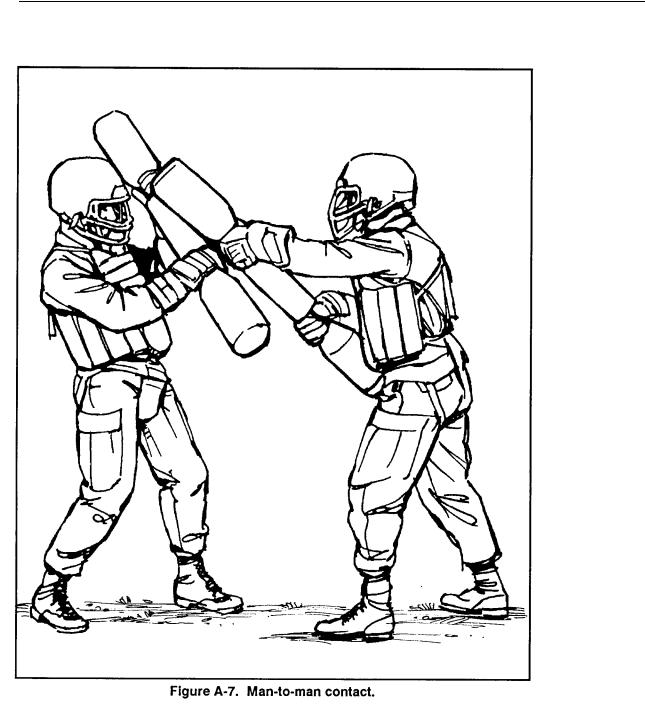
FM 21-150
a.The instructor must consider several factors to gain maximum effectiveness from pugil training. These include training, control, supervision, safety, and protective equipment.
b.The instructor should teach the rifle-bayonet fighter the basic positions and movements, as well as the series of follow-up movements, with the rifle-bayonet before beginning pugil training.
A-5
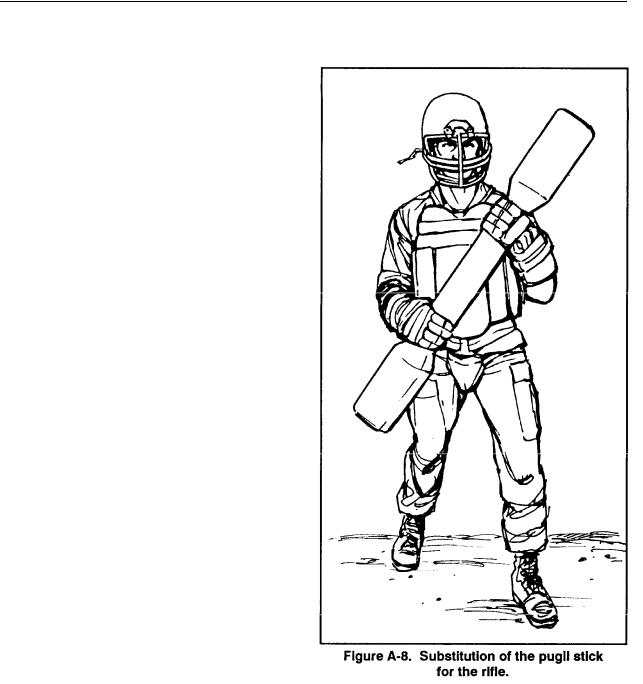
FM 21-150
c. The pugil stick should approximate the length and weight of the M16 rifle with bayonet attached for maximum training benefit. Substitution of the pugil stick for the rifle provides an opportunity to improve skill and test each soldier’s ability to perform against a realistic, evasive target. All the positions and movements with the pugil stick are the same as with the rifle and bayonet (Figure A-8).
A-8. CONTROL,
SUPERVISION, AND
SAFETY
Instructors supervising pugil training must understand its values and limitations. The instructor maintains control of the bout at all times; his best method of control is by blowing a whistle to start and stop action. He is alert to prevent wild swinging of the pugil sticks, and he ensures that the soldiers keep their eyes on each other. For safety reasons, he should pair soldiers who are about the same height and weight.
a.Soldiers use only the positions and movements that they have been taught in rifle-bayonet training. They must hold the stick and deliver blows as if using the rifle-bayonet.
b.One instructor is necessary for each bout; however, he needs assistance
to supervise the fitting and exchanging of equipment. The instructor makes sure the equipment fits properly and watches constantly for any loose or broken equipment. As soon as he sees any insecure equipment, he stops the
A-6

FM 21-150
bout to prevent possible injuries. After deficiencies have been corrected, the
round is resumed.
c.The instructor insists that the soldiers growl during the bouts; this adds to their aggressiveness and tends to reduce tension.
d.Soldiers with medical problems, such as hernias, frequent headaches, previous brain concussions, recent tooth extractions, or lacerations with stitches, must be excluded from pugil training for safety reasons. Therefore, before conducting pugil training, it is necessary to determine if anyone should be eliminated from participation. Finally, instructors should always be alert for the unexpected and, if in doubt, stop the bout immediately to prevent injury.
A-9. WARM-UP ROUND
In the early stages of pugil training, maximum benefit is gained by working with platoon-size groups (or smaller) in a circular formation. Two soldiers engage in a pugil bout in the center of the circle. An instructor critiques them so all soldiers can learn from observed mistakes. The soldiers assume the attack position 12 steps from each other. In the first round, the instructor allows them freedom of movement to prove to soldiers that the equipment provides ample protection from a hard blow. Everyone should take part in as many bouts as necessary to gain skill before going on to more advanced training. Immediately after the warm-up round, the soldiers engage in graded bouts.
A-10. GRADED BOUTS
During graded bouts (Figure A-9, page A-8), the opponents face each other, 12 steps apart. The instructor should be in a position where he can best control the bout. Each bout consists of three rounds. To score a point or win a round, a soldier must score a solid blow with either end of the pugil stick to a vulnerable point—the head, throat, chest, stomach, or groin region.
a.To start a bout or a round, the instructor blows the whistle, and the soldiers move toward each other in the attack. The instructor awards one point to the soldier striking the first disabling blow. A disabling blow is any blow that is delivered to a vulnerable part of the opponent’s body. When a soldier strikes such a blow, the instructor uses a whistle to stop the round. At the end of the round, soldiers move back to their respective lines, assume the attack position, and wait for the signal to start the next round. The soldier who wins two out of three rounds wins the bout.
b.The instructor should encourage soldiers to move in aggressively and to attack violently, using any of the attack movements learned during
rifle-bayonet training. If the soldier misses or his opponent sidesteps, he should immediately follow up until he has landed a blow to a vulnerable spot.
A-7
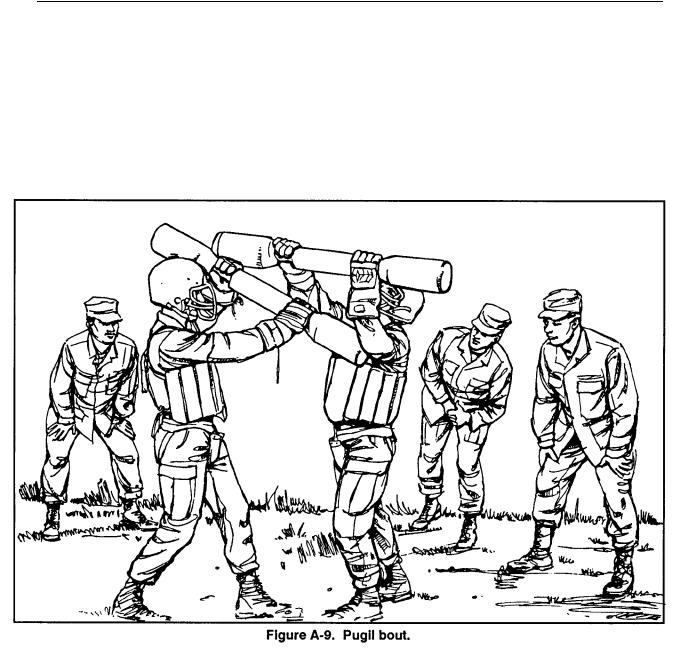
FM 21-150
c.The soldier who hesitates to strike his opponent realizes that defeat can be quick; therefore, he tries to be aggressive and overcome his opponent in the shortest possible time.
d.Because training is done in two-man bouts, a squad, platoon, and finally a company champion may be selected. The instructor should encourage competition throughout the pugil training program.
A-11. PUGIL COURSES
After several two-man bouts, the rifle-bayonet fighter is ready for the human thrusting target course and the human thrusting assault course.
a. Human Thrusting Target Course. Eight to ten soldiers are lined up in file formation, 12 steps apart. The instructor selects each soldier to act as a specific-type target. The rifle-bayonet fighter, also in pugil gear, walks to each human target, moving with the pugil stick at the attack position. As the rifle-bayonet fighter approaches an opponent, the opponent shouts the movement that the rifle-bayonet fighter is to execute—for example, thrust,
A-8

FM 21-150
slash, butt stroke. After executing the movement, the rifle-bayonet fighter pauses long enough for the instructor to make corrections, then he moves to the next target. The number of walk-throughs depends on each soldier’s ability to execute the movements correctly. Next, he runs through the course at full speed, growling and executing the called movements with maximum force against his opponents. The duties are rotated so that all soldiers get to act as fighters and as human targets.
b. Human Thrusting Assault Course. A qualification-type course can be conducted to measure each soldier’s skill. This course should approximate an obstacle course in length, obstacles, and terrain. The course layout should take advantage of natural obstacles, such as streams, ditches, hills, and thickly wooded areas. Soldiers in pugil equipment can be placed among the obstacles to act as human targets. The rest of the unit, in pugil equipment, can negotiate all obstacles and human targets, using instinctive rifle-bayonet fighting movements.
A-9
APPENDIX B
BAYONET TRAINING
After instruction on a bayonet training court, soldiers train on a bayonet assault course, if available, to improve their skills as rifle-bayonet fighters Instructors grade all previously learned techniques on the qualification course, which places demands on the soldier that approach near-combat situations.
B-1. BAYONET COURT
Before training on the assault course, instructors may use the bayonet training court (Figure B-1, page B-2) for preliminary training to teach soldiers how to attack while moving rapidly toward an enemy. To use the course in this way, soldiers are lined up behind each of the 10 files of targets (two files are blocked by the instructor’s platform). The instructor/assistant instructor must designate the movement to be executed against each target. On command, the soldiers negotiate the course in waves of 10 soldiers abreast. As they complete the course, they should clear the last target and again line up in their respective files at that end of the course. After all soldiers have completed the course, it may be run again in the opposite direction.
B-1
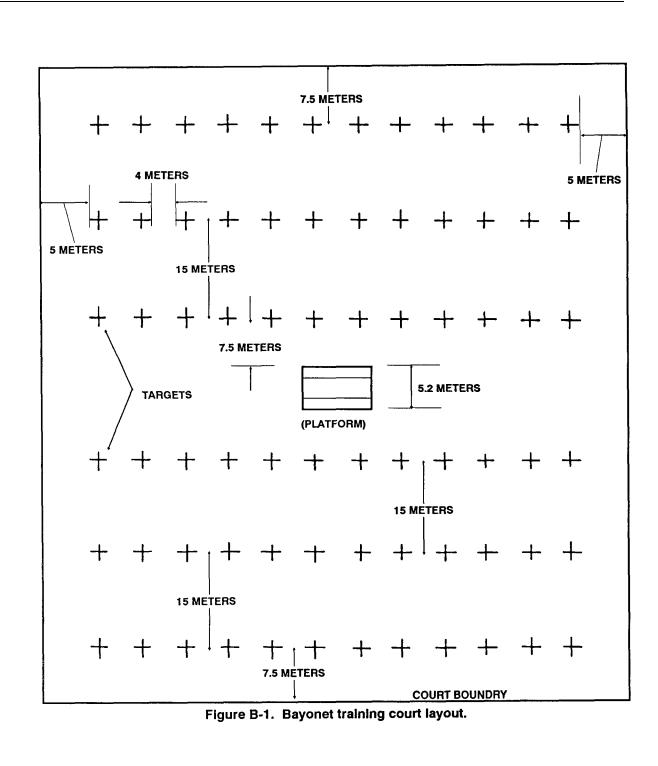
FM 21-150
B-2

FM 21-150
B-2. BAYONET ASSAULT COURSE
A bayonet assault course has a series of lanes to accommodate several soldiers negotiating the course at the same time. The course has targets to attack and obstacles to overcome; it should be laid out on rough, preferably wooded terrain. The length of the course should be 300 meters; however, less space is acceptable if terrain dictates. (See paragraph 2-7.) Natural obstacles (such as stream, ravines, ridges, and thickly wooded areas) and artificial obstacles (such as dirt mounds, craters, wire entanglements, fences, log wall, hurdles, and horizontal ladders) should all be a part of the course.
a.Objectives. Instructors may also use the bayonet assault course as a qualification course to test the rifle-bayonet fighter’s degree of skill. When used as a part of rifle-bayonet training, the course—
(1)Aids in developing speed, strength, endurance, coordination, and accuracy.
(2)Provides rifle-bayonet fighting under combat-like conditions.
(3)Offers a challenge to the soldier’s determination and will power that is so essential in combat.
(4)Provides a means for establishing good habits in group action and teamwork.
(5)Measures skill in rifle-bayonet fighting.
(6)Provides a means for maintaining skill by continued training and practice.
b.Negotiation. Instructors should explain and demonstrate the method of negotiating the assault course before the soldiers are required to run the course. Instructors should emphasize the importance of swift and continuous bayonet attack. Soldiers run the course with their rifles in the attack position, and they attack without hesitation.
(1)Practice running. While practicing, soldiers first negotiate the course at a moderate pace and then increase their speed as technique and physical
condition improve. The instructor must maintain discipline and organized control. He and his assistants station themselves along the course to observe the methods of attack and to make corrections when necessary.
(2) Targets. The unit running the course should construct different types of targets. Soldiers should gain experience on four basic targets before running the qualification course. These targets are the thrust, parry thrust, parry butt stroke to the groin, and parry butt stroke to the head (Figure 2-3). These targets are durable and, if used properly, will not damage rifles. If substitution must be made, the unit should not use hard objects or materials for butt stroke heads or target faces that will cause rifle damage.
B-3
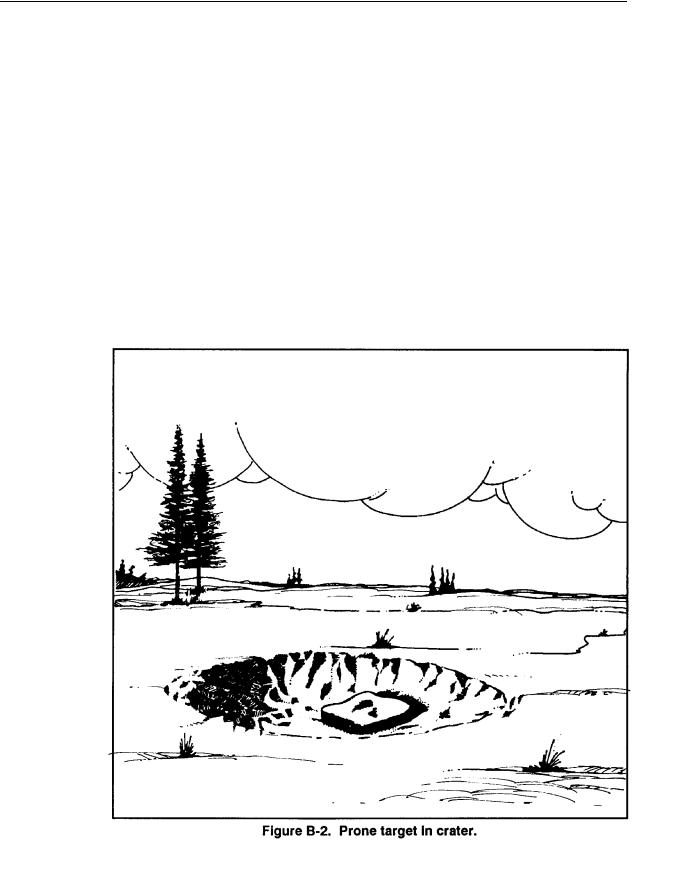
FM 21-150
B-3. QUALIFICATION
The qualification course gives the unit commander a means to measure the skill of his soldiers in the technique of rifle-bayonet fighting. This course increases esprit de corps within a unit by creating a competitive attitude and by offering special recognition to soldiers who qualify. Instructors can use the same course for both practice and qualification. They can also determine qualification on any assault course.
a.The assault qualification course contains at least four types of targets (Figure 2-3) to include thrust, parry thrust, parry butt stroke to the groin, parry butt stroke to the head, or prone target in crater (Figure B-2). It also has seven types of obstacles as shown in Figures 2-4 through 2-10.
b.The course contains a minimum number of lanes to permit one-half of a squad to run at the same time under the squad leader, assistant squad leader, or other designated leader.
B-4

FM 21-150
c. For qualification, the soldier takes up the prone position in the rear of the starting line. At the command, UP, he springs to his feet with his weapon at the attack position and runs toward the first target. He then negotiates each obstacle and attacks each target in turn, running the course in the shortest possible time. The instructor or assistant instructor scores each soldier individually.
d. To conduct qualification runs of the assault course, the instructor and the NCOIC or OIC must provide the following:
(1)Supervisory personnel. To ensure impartial scoring and to maintain high standards for qualification, the instructor details soldiers who are not members of the unit being tested to act as scorers. He should select scorers well in advance so the NCOIC or OIC can refresh himself on the subject and, if necessary, train the scorers. The unit should detail an NCOIC or OIC experienced in rifle-bayonet training to administer the course. His primary duty is to assign a scorer to each target and to ensure that the scorer is qualified to grade soldiers on the execution of the movements for that target. The NCOIC or OIC has overall supervisory responsibility for the scoring. He provides each scorer with scoresheets, then totals each soldier’s score for the entire course.
(2)Scoring standards. Since assault courses at different installations may vary as to length and number of targets, it is not practical to prescribe a
standard time limit or an invariable number of points for qualification. As a guide, the NCOIC or OIC can use 30 seconds for each 50 meters of a course to establish a time limit. However, the total distance covered should be 300 meters. On short courses, it is necessary to rerun parts of the course to cover the required distance and to attack the recommended eight targets. To qualify, the soldier must score at least 75 percent of the total possible points and negotiate the course within the specified time limit. The NCOIC or OIC should orient each man thoroughly on all requirements for the qualification course, including the maximum time allowed and the minimum number of points needed to qualify.
(3) Awards. A basic qualification badge, as specified in AR 672-5-1, with the bayonet bar to indicate expert qualification is awarded to participants who attain the qualifying score of 75 percent.
B-4. SCORESHEETS
The NCOIC or OIC uses three scoresheets to record the score of soldiers who complete the bayonet assault course.
a. Bayonet Target Scoresheet. Target scores are recorded on DA Form 1770-R (Bayonet Target Scoresheet) (Figure B-3). A blank copy of this form is located in the back of this publication for local reproduction on
B-5
